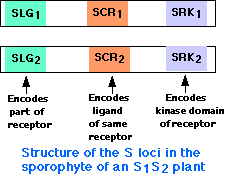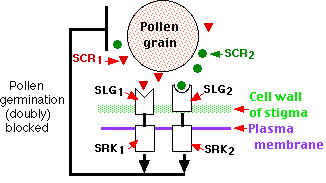| Index to this page |
| Link to a discussion of sexual reproduction in angiosperms. |
A variety of solutions have been tried in the plant kingdom.
These include:The flowers are perfect but come in two structural types; for example
A single plant has one type or the other.
If the pollinator has a short tongue, pollination is favored from the first type to the second - but not the reverse.
Heteromorphic flowers are not common, and even in the angiosperm families that favor them (e.g., primroses, flax), the same biochemical mechanisms of self-incompatibility that we will find (below) in homomorphic flowers are usually present as well.
This form of self-incompatibility has been studied intensively in members of the mustard family (Brassica), including turnips, rape, cabbage, broccoli, and cauliflower.
 In this system,
In this system,


 The rules:
The rules:
| Welcome&Next Search |